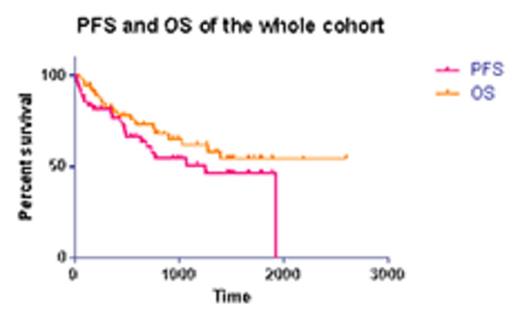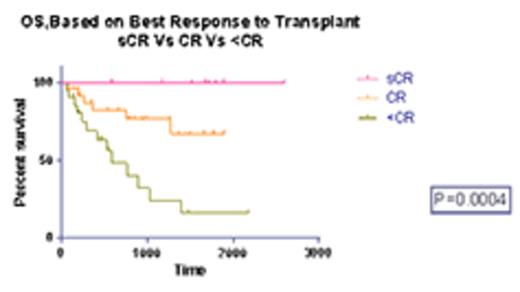Abstract
Aim/Background:
Multiple myeloma (MM) is a malignant plasma cell disorder predominantly of the elderly. Current treatment modalities, including newer drug combinations and autologous stem cell transplantation (ASCT) offer longer and deeper responses, but none of them are curative. Furthermore, a subgroup of patients (approximately 20%) with high risk features manifest aggressive disease at onset with only short term or no response with available therapies. Non-myeloablative allogeneic stem cell transplantation (NMA) is a therapeutic option in these settings and maybe potentially curative. We undertook a retrospective analysis of MM patients who underwent tandem ASCT-NMA at our centre. Primary objectives were to evaluate the disease outcomes and treatment related complications experienced by these patients
Method:
Between May 2008 and March 2015, 55 patients referred to the Alfred Hospital, Melbourne with MM underwent either 'upfront' or 'deferred' tandem autologous (ASCT) /nonmyeloblative (NMA) transplantation procedure as part of their disease management. The decision for upfront tandem transplant was based on the presence of at least 2 of 5 high risk features exhibited by the patients, these included ISS score 3, plasma cell leukemia, elevated LDH, adverse cytogenetics [t(4;14),17p- or complex karyotype] and induction failure (<PR) with bortezomib or immunomodulatory agent containing therapy. ASCT were conditioned with melphalan 200mg/m2; NMA were conditioned with oral fludarabine 48mg/m2 on days -4 to -2 and 2Gy TBI on day 0. Forty seven patients received their allografts as outpatients. All patients received cyclosporine and mycophenylate mofetil for graft versus host disease prophylaxis.
Results:
Twenty seven patients underwent upfront tandem ASCT/NMA transplantation - median age 51 years (range, 22-62 years) and 28 patients underwent deferred ASCT/NMA transplantation - median age 57 years (range, 47-67 years). Thirty four patients were males. Median follow up was 862 days (115-2659 days). Median time between ASCT and NMA was 98 days (50 - 336 days). 23 patients had matched sibling donors and 32 had matched unrelated donors. All patients engrafted with neutrophils never below 0.5 x 109/l in 42% patients and platelets never below 20 x 109/l in 93% patients. Median neutrophil recovery occurred on day 11 (range 0-26 days). Acute GVHD occurred in 49% of patients. Incidence of Grade II-IV AGVHD was 29% (22% upfront patients and 35% deferred patients (p=0.27)). CGVHD occurred in 67% of evaluable patients (68% upfront patients and 67% deferred patients p=0.92). The proportion of patients who required ongoing treatment for active chronic GVHD at 1yr, 2yrs and 3yrs was 51%, 29% and 18%, respectively. Transplant related mortality (5 GVHD; 2 infection) was 12.7% (5 [19%] upfront patients and 2 [7%] deferred patients). Twenty two patients (40%) progressed post allograft (30% upfront patients and 50% deferred patients [p=0.12]). Twelve patients died from primary disease (3 upfront patients and 9 deferred patients). Progression free survival (PFS) and overall survival (OS) of the whole group at 5yrs were 46.5% and 54.3% respectively.Comparing the two cohorts at 3 and 5 years, OS was higher, although not statistically significant, in the upfront cohort (75% vs 52% at 3 years, p=0.13 and 63% vs 42% at 5 years, p=0.22).Patients who achieved VGPR or better prior to transplant had a better PFS (median PFS 1922 days versus 686 days, p=0.01) compared to the rest but no OS benefit is yet evident for this group. However, patients who achieved stringent CR post transplant had significantly superior PFS and OS compared to those who did not (median PFS; sCR versus CR versus <CR= not reached versus 1922 days versus 474 days, respectively,p=0.0008; and, median OS; sCR versus CR versus <CR= not reached versus not reached versus 581 days, respectively, p=0.0004). There was no significant difference in outcome between matched sibling and VUD donor transplants.
Conclusion:
Tandem ASCT-NMA transplantation is an effective approach as an upfront treatment for appropriately selected poor risk MM patients and for salvaging relapsed patients, with acceptable treatment related morbidity and mortality. Response status achieved post transplantation has a highly significant impact on long-term survival.
Off Label Use: Fludarabine was used as part of conditioning regimen for allogeneic stem cell transplantation.
Author notes
Asterisk with author names denotes non-ASH members.




This feature is available to Subscribers Only
Sign In or Create an Account Close Modal